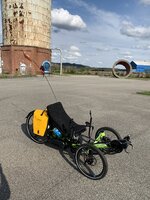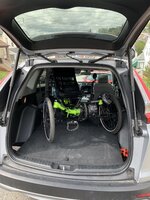Having just recently completed a tour on my ICE Adventure, I thought I'd add my experience. First, I rode from Omaha, NE to Moline, IN. The bike trails in Omaha and Council Bluffs are good. You then ride the roads for quite a ways, until you get to the center of Iowa, where the rail trails are great. Then it is more road riding to Davenport, where you get some more bike trails. The road riding was problematic, as many of the small towns don't even have a convenience store, hotel, or place to camp. The roads were two-lane, with a gravel shoulder, and many had rumble strips. With a trike, I had to ride in the traffic lane, hugging the right side. All but one of the motorists were very courteous, giving me a wide berth. One guy tried to see how close he could come without hitting me. It was a few inches. Iowa is not flat. The roads are very hilly. Riding across Iowa, more than half of the distance was on the roads, vs rail trails. It took me eight days. Most of the rail trails in Iowa are crushed rock, with some paved sections. The vast majority is quite good riding, but little shade. I would recommend driving to the center of Iowa to ride those trails, and skipping the East/West sections of road.
After getting to Moline, I rented a car to drive East. A Ford Edge is large enough to carry my folded trike, with the seat removed. Later, I rented a Dodge of similar size. Speaking of car rentals, the only company that I could find for one way rentals was Avis/Budget (both owned by the same company).
I then rode the GAP from Pittsburgh, PA to Cumberland, MD, a distance of 150 miles. This took me 2.5 days. The GAP is crushed rock, with short paved sections around towns. It is quite wide and smooth, most of it being shaded. There are some B&B's, a few hotels, and a few campgrounds along the trail. The GAP is highly recommended.
While riding the GAP, I had the impression that there wasn't much uphill/downhill. It seemed to be a steady, gentle uphill. When I got to the Eastern Continental Divide Tunnel, I saw that I was right. In the tunnel is an elevation profile, showing a constant uphill from Pittsburgh, and a steeper downhill into Cumberland. It was such a joy riding into Cumberland.
After the GAP, I started on the C&O Canal. Even though there had only been a little rain, the trail was muddy and miserable. It is definitely not for trikes, as the trail is mostly two narrow, muddy tracks with a grassy mound in the center. Also, the Paw Paw Tunnel has been closed for years, so you have to arrange a shuttle ride around it. This was a problem, as most people offering shuttle service only transport bikes. After calling three people, the last person called someone he knew with a pickup truck. Below the tunnel, there was some construction, and the trail took a detour for a few miles, which was very steep, muddy and rocky. Thankfully, I was going downhill. I met about a dozen young riders who were going the other direction. It was a hard slog for them.
I didn't finish the C&O, as in Hancock, MD, I had a small accident which damaged the trike. I'll have to try again, another time.
Several people told me that below Harper's Ferry, the C&O is more like the GAP, and not so narrow and muddy. Along the trail, there are no stores or accommodations, but there are primitive campgrounds every 5-10 miles. These have water, but nothing else. If you want supplies, you have to leave the trail.
After repairing the trike, I did ride a rail trail that runs through MD and PA. It's all the same railroad, but in MD, it's called the Torrey C Brown Trail, and in PA, the York Heritage Trail. Each section is approximately 20 miles. Both are similar to the GAP, although the MD section is not as nicely maintained. Also, there are very few towns along the MD section, if you want to stop for a cold drink. I did each section separately, up and back, in less than a day each. There is a very small park just North of the MD state line, which is a convenient halfway point.
All told, I rode about 700 miles, which was much less than I had planned. The road riding was a grind, but I just kept going, looking forward to the next rail trail. Except for the muddy C&O, the rail trails were a joy to ride. In June/July, the weather was very humid, and the insects were thick, especially in Iowa. Early Spring or Fall would be a better time. Living in the Southwest, I like the low humidity and lots of sunshine. In MD, you rarely saw the sun, and it rained often.

